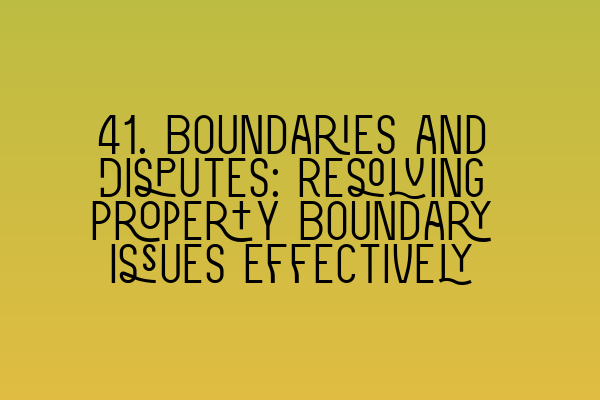41. Boundaries and Disputes: Resolving Property Boundary Issues Effectively
Welcome to the blog of SQE Property Law & Land Law. In today’s post, we will discuss an important aspect of property ownership – boundaries and disputes. Property boundaries are the lines that separate one property from another, and disagreements regarding these boundaries can often lead to heated disputes between neighbors.
Resolving property boundary issues effectively requires a sound understanding of the law, as well as good communication and negotiation skills. Whether you are a property owner, a solicitor, or simply interested in property law, this article will provide you with valuable insights on how to navigate through boundary disputes.
The Importance of Accurate Boundary Determination
Accurate boundary determination is crucial for establishing legal ownership and avoiding conflicts. Property boundaries are typically defined in the Land Registry documents, such as deeds or title plans. However, these documents may not always provide crystal clear guidance, especially in older properties where historical records may be incomplete or inconsistent.
It is essential to consult with a qualified solicitor who specializes in property law to assess the available evidence and interpret the legal framework in order to establish the correct boundary lines. Engaging an expert will ensure that you have the right information to make informed decisions and protect your interests.
Common Boundary Disputes and their Resolution
Boundary disputes can arise due to a variety of reasons, such as encroachments, unclear boundaries, or conflicting interpretations of land documents. Let’s explore some common types of boundary disputes and the strategies that can be employed to resolve them effectively:
- Encroachments: Encroachments occur when a neighbor’s structure, such as a fence, wall, or tree, extends beyond their property line and encroaches onto your land. In such cases, it is important to carefully review the boundary documents and consult with a solicitor to determine the extent of the encroachment and establish your legal rights. Mediation or negotiation with your neighbor may be attempted to find a mutually acceptable solution.
- Unclear or Ambiguous Boundary Lines: Unclear boundary lines can lead to confusion and conflicting interpretations of land ownership. In such situations, it is advisable to refer to the Land Registry documentation, historic evidence, and expert opinions to establish the precise location of the boundary. This may involve conducting surveys, consulting with surveyors or even applying to the Land Registry for a determined boundary. These steps will help provide clarity and certainty for all parties involved.
- Nuisance Claims: Nuisance claims arise when one property owner’s activities, such as noise, pollution, or interference with the use and enjoyment of the property, cause unreasonable harm to a neighboring property. Nuisance claims can sometimes intersect with boundary disputes, as the alleged nuisance may be occurring near the disputed boundary. Adequate evidence and documentation, including expert reports and witness statements, should be gathered to support the claim and establish liability.
- Seeking Legal Remedies: If negotiations or mediation fails, it may be necessary to resort to legal remedies to resolve a boundary dispute. This could involve filing a claim in court for a declaratory judgment to determine the correct boundary line or seeking an injunction to prevent a neighbor from continuing to trespass on your property. Engaging a specialized property law solicitor who has experience in boundary dispute resolution will greatly enhance your chances of success.
Preventing Boundary Disputes: A Proactive Approach
While disputes over property boundaries can be stressful and time-consuming, there are steps you can take to prevent them in the first place:
- Thoroughly review property documents: Before purchasing a property, ensure that you carefully review all relevant property documents, including deeds, title plans, and survey reports. This will help identify any potential boundary issues and allow you to seek clarification before finalizing the transaction.
- Communicate with neighbors: Establishing good relationships with your neighbors is key to preventing potential boundary disputes. Regular open communication can help address any concerns or misunderstandings and promote cooperation in resolving boundary-related matters.
- Regular property maintenance: Regularly inspect and maintain your property, including fences, walls, and hedges, to ensure that they remain within your boundaries. Promptly address any encroachments or issues that may arise, and consult with a solicitor if necessary.
- Obtain professional advice: When in doubt, consult with a solicitor or surveyor who specializes in property law to obtain professional advice. Seeking expert guidance can help you navigate the complexities of property boundaries and minimize the risk of future disputes.
Resolving property boundary issues effectively requires a comprehensive understanding of property law, strong negotiation skills, and a proactive approach to prevent disputes. By following these strategies, you can protect your property interests and ensure peaceful coexistence with your neighbors.
If you would like to explore SQE preparation courses or learn more about SRA SQE examination dates, please feel free to visit our related articles:
- SQE 1 Practice Exam Questions
- SQE 1 Practice Mocks FLK1 FLK2
- SQE 2 Preparation Courses
- SQE 1 Preparation Courses
- SRA SQE Exam Dates
Thank you for reading our blog post on property boundaries and disputes. We hope you found it informative, and don’t hesitate to contact SQE Property Law & Land Law if you have any further questions or require legal assistance.
